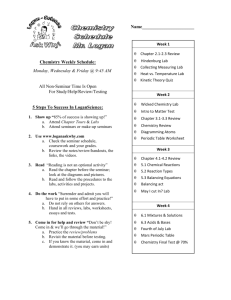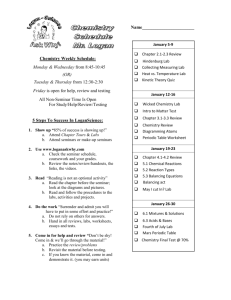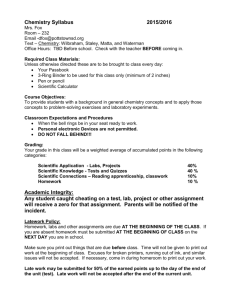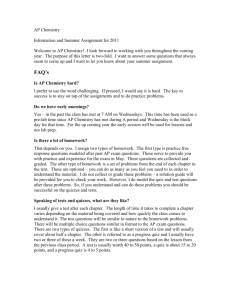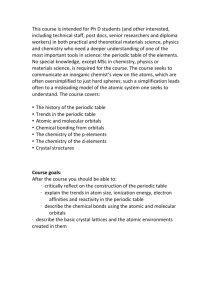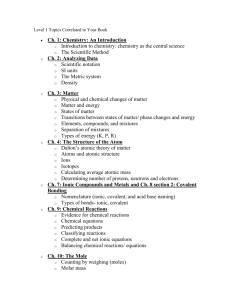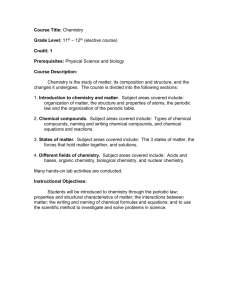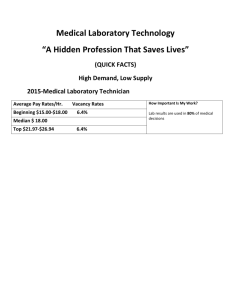ICP Syllabus 2014-2015
advertisement
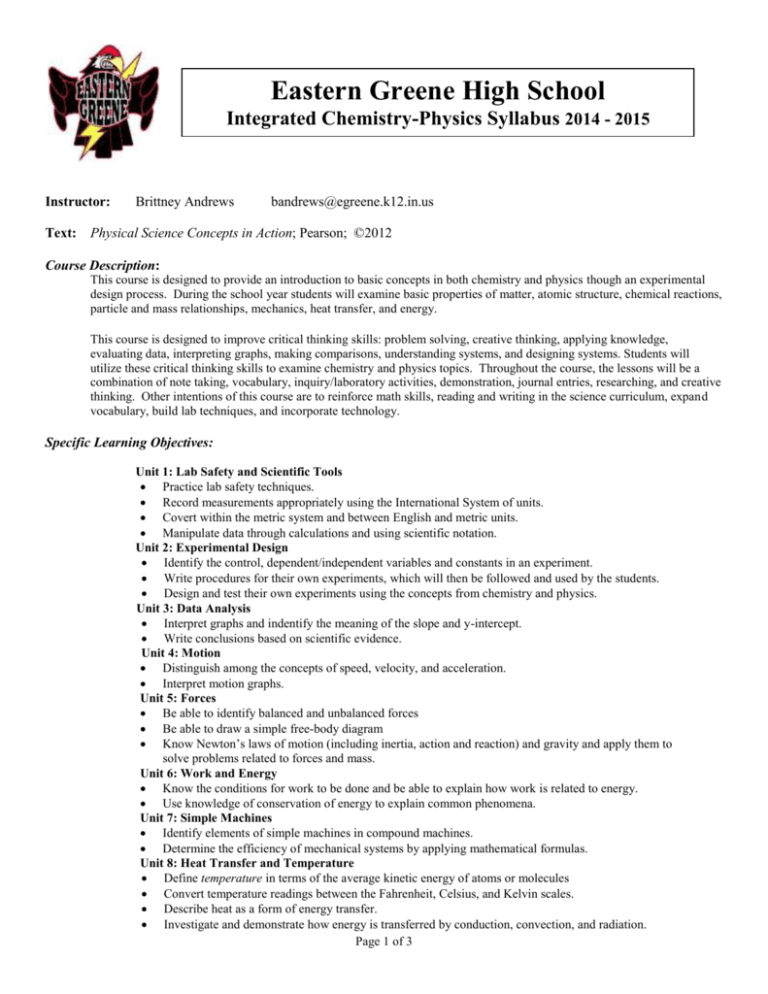
Eastern Greene High School Integrated Chemistry-Physics Syllabus 2014 - 2015 Instructor: Brittney Andrews bandrews@egreene.k12.in.us Text: Physical Science Concepts in Action; Pearson; ©2012 Course Description: This course is designed to provide an introduction to basic concepts in both chemistry and physics though an experimental design process. During the school year students will examine basic properties of matter, atomic structure, chemical reactions, particle and mass relationships, mechanics, heat transfer, and energy. This course is designed to improve critical thinking skills: problem solving, creative thinking, applying knowledge, evaluating data, interpreting graphs, making comparisons, understanding systems, and designing systems. Students will utilize these critical thinking skills to examine chemistry and physics topics. Throughout the course, the lessons will be a combination of note taking, vocabulary, inquiry/laboratory activities, demonstration, journal entries, researching, and creative thinking. Other intentions of this course are to reinforce math skills, reading and writing in the science curriculum, expand vocabulary, build lab techniques, and incorporate technology. Specific Learning Objectives: Unit 1: Lab Safety and Scientific Tools Practice lab safety techniques. Record measurements appropriately using the International System of units. Covert within the metric system and between English and metric units. Manipulate data through calculations and using scientific notation. Unit 2: Experimental Design Identify the control, dependent/independent variables and constants in an experiment. Write procedures for their own experiments, which will then be followed and used by the students. Design and test their own experiments using the concepts from chemistry and physics. Unit 3: Data Analysis Interpret graphs and indentify the meaning of the slope and y-intercept. Write conclusions based on scientific evidence. Unit 4: Motion Distinguish among the concepts of speed, velocity, and acceleration. Interpret motion graphs. Unit 5: Forces Be able to identify balanced and unbalanced forces Be able to draw a simple free-body diagram Know Newton’s laws of motion (including inertia, action and reaction) and gravity and apply them to solve problems related to forces and mass. Unit 6: Work and Energy Know the conditions for work to be done and be able to explain how work is related to energy. Use knowledge of conservation of energy to explain common phenomena. Unit 7: Simple Machines Identify elements of simple machines in compound machines. Determine the efficiency of mechanical systems by applying mathematical formulas. Unit 8: Heat Transfer and Temperature Define temperature in terms of the average kinetic energy of atoms or molecules Convert temperature readings between the Fahrenheit, Celsius, and Kelvin scales. Describe heat as a form of energy transfer. Investigate and demonstrate how energy is transferred by conduction, convection, and radiation. Page 1 of 3 Identify and distinguish between conductors and insulators. Unit 9: Matter and Phase Changes Differentiate between matter and energy. Describe phases of matter according to the Kinetic Molecular Theory. Unit 10: Properties of Matter Explain concepts about the structure and properties of matter. Identify and differentiate between chemical and physical properties of matter. Classify matter as elements compounds or mixtures based upon distinguishing characteristics. Determine chemical and physical changes based upon observations. Unit 11: Atoms and the Periodic Table Know that atoms are composed of even smaller sub-atomic structures whose properties are measurable. Explain the repeating pattern of chemical properties by using the repeating patterns of atomic structure within the periodic table. Determine ionization patterns of families within the Periodic Table and infer chemical properties. Calculate mass/mole relationships based upon atomic mass. Unit 12: Chemical Bonding Explain the formation of compounds and their resulting properties using bonding theories (ionic and covalent). Recognize formulas for simple inorganic compounds (ionic and molecular compounds), and diatomic elements. Unit 13: Chemical Reactions Describe various types of chemical reactions by applying the laws of conservation of mass and energy. Identify the five types of chemical reactions, and determine common products. Balance chemical equations. Unit 14: The Chemistry of Life Know how a solution is formulated. Be able to explain and apply the concepts of solubility and concentrations. Know the properties of acids and bases. Be able to explain how water and carbon chemistry lay the foundation for life. Classroom Rules, Policies, and Procedures: 1) 2) 3) 4) 5) 6) Follow ALL school rules set forth in your student handbooks. Come to class prepared (bring your notebook, a pencil, and a calculator)! Cell phones are to be placed in the closet at the beginning of each class. Listen when others are speaking and participate in discussions. Show respect for others and yourself. Come to class with a positive attitude Consequences: Every Offense –You will sign the “Warning” Sheet. If your name appears a total of 3 times on this list, it is an automatic referral to administration for disciplinary action (This means a detention) AND a phone call home. Evaluation: A. Lecture: Classes will be conducted primarily with problem solving after short lectures, note-taking, and presenting of materials. The class is structured for individual and group work. B. Labs: Classes will conduct labs applicable to concepts attained. In turn, they will also learn to write lab reports as outlined by the scientific method of problem solving. Some labs will include computerized lab interfaced equipment. C. Reading: Classes will practice reading in the science curriculum. Each unit will involve a reading activity. D. Writing: Classes will maintain a science writing journal which can include a plethora of writing including lab reports, opinion papers, critical thinking skills, etc. E. Homework and Class Participation: Students are expected to actively participate in discussions and whiteboard activities, complete all labs, take notes, write journals, complete homework assignments, and research topics. F. Projects: Classes will develop several projects throughout the year applying those concepts learned in class. G. Assessments: Classes will take an end of unit test and are expected to keep up and be prepared for unannounced quizzes. H. Class Attendance: Regular class attendance is an essential component for success in this class. I. Grades will be weighted and based upon the following: 1. Tests and Pop Quizzes 60% 2. Labs and Projects 20% Page 2 of 3 3. Homework 20% Page 3 of 3
